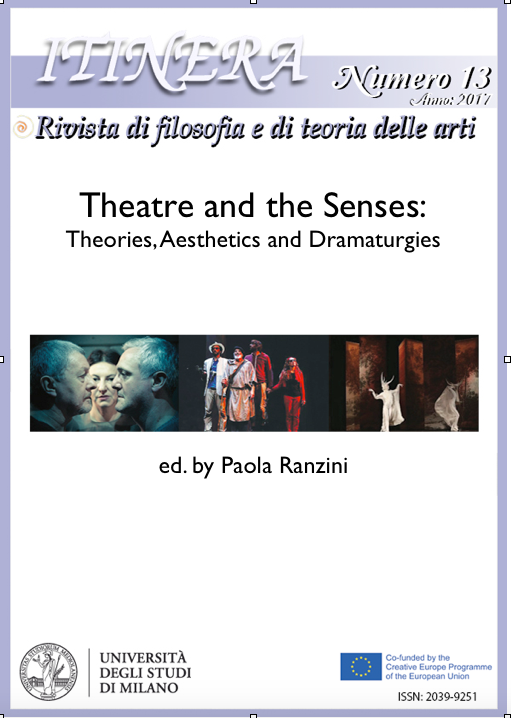Chair de théâtre, chair du monde
DOI:
https://doi.org/10.13130/2039-9251/8714Abstract
As soon as the light inside the theatre fades (usually very slow, almost stealthily, in order to avoid a brusque transition), a switch of codes of perception takes place. Not from reality to fiction, as if these were two separate worlds, but from one way of watching to another. Watching becomes the key in a strategy between showing and hiding, receiving and hiding back. The spectator is all but passive. All your mental and sensory faculties are focussed on digesting a flood of impressions in the course of a performance. It does not merely involve watching, but it concerns a receptivity that encompasses one’s whole physical being. How can we understand this ‘global’ perception ? What takes really place on a sensory level ? How does a spectator respond to a performance in a theatre landscape were new theatrical forms appeal to varied sorts of stimuli and sensations ? What can we learn from the field of embryology concerning our senses ? And how can we integrate the sensorial dimension into the envelop of the world ? What does it mean to be in the flesh of the theater at the heart of the world ?
Riferimenti bibliografici
ABRAM, David, The spell of the sensuous, Vintage Books Edition, 1997.
AMEISEN, Jean-Claude, La sculpture du vivant, Editions du Seuil, Paris 1999.
BAINBRIDGE COHEN, Bonnie, Sensing, Feeling, and Action. The experiential anatomy of Body-Mind Centering®, 3d edition, Contact Editions, Northampton 2012.
DE LAET, Timmy, CASSIERS, Edith, VAN DEN DRIES, Luk, « Creating by annotating : the director’s notebooks of Jan Fabre and Jan Lauwers », Performance Research, 20 : 6 (2015), p. 43-52.
DE LAET, Timmy, CASSIERS, Edith, VAN ROY, Frederik, VAN DEN DRIES, Luk, « Redrawing bodily boundaries : a look into the creative process of Jan Fabre », in : GONZALEZ, Madalena et al. (dir.), Aesthetics and ideology in contemporary literature and drama, Cambridge Scholars Publishing, Cambridge 2015, p. 297-320.
DE LAET, Timmy, Re-inventing the Past. Strategies of Re-enactment in European Contemporary Dance, Doctoral thesis, University of Antwerp, 1996.
DI BENEDETTO, Stephen, The Provocation of the Senses in Contemporary Theatre, Routledge, New York, London 2011.
FABRE, Jan, Le temps emprunté, Actes-Sud, Arles 2007.
FABRE, Jan, OLYSLAEGERS, Jeroen, Mount Olympus. To Glorify the Cult of Tragedy. Het script, Bezige Bij, Amsterdam 2016.
GLÖCKLER, Michaela, VAN DER WAL, Jaap (Hg.), Dynamische Morphologie und Entwicklung der menschlichen Gestalt. Spirituelle Schulungsmotive für Physiotherapeuten, 4. bearbeitete Auflage 2016, Verlag am Goetheanum, Dornach.
MERLEAU-PONTY, Maurice, Le visible et l’invisible, Gallimard, Paris 1964.
VAN DEN DRIES, Luk, Corpus Jan Fabre. Observations sur un processus de création, L’Arche, Paris 2005.
VAN DEN DRIES, Luk, Jan Fabre. Het geopende lichaam, De Bezige Bij, Antwerpen 2014.
Dowloads
Fascicolo
Sezione
Licenza
Gli autori che pubblicano su questa rivista accettano le seguenti condizioni:
1. Gli autori mantengono i diritti sulla loro opera e cedono alla rivista il diritto di prima pubblicazione dell'opera, contemporaneamente licenziata sotto una Licenza Creative Commons - Attribuzione - Condividi allo stesso modo 4.0 internazionale che permette ad altri di condividere l'opera indicando la paternità intellettuale e la prima pubblicazione su questa rivista.
2. Gli autori possono aderire ad altri accordi di licenza non esclusiva per la distribuzione della versione dell'opera pubblicata (es. depositarla in un archivio istituzionale o pubblicarla in una monografia), a patto di indicare che la prima pubblicazione è avvenuta su questa rivista.
3. Gli autori possono diffondere la loro opera online (es. in repository istituzionali o nel loro sito web) prima e durante il processo di submission, poiché può portare a scambi produttivi e aumentare le citazioni dell'opera pubblicata (Vedi The Effect of Open Access).





